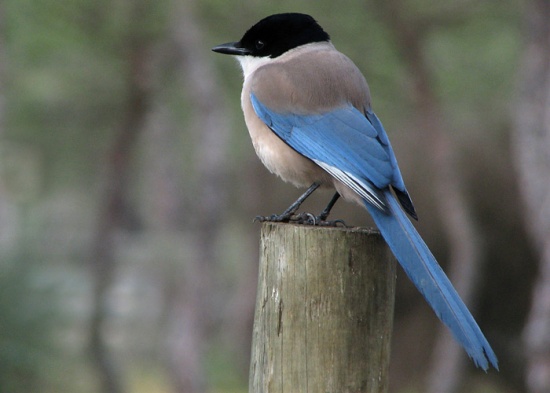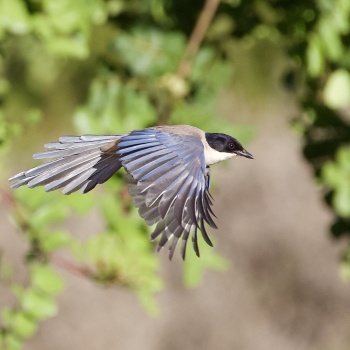Alternative Name: Iberian Azure-winged Magpie, Cook’s Azure-winged Magpie, Spanish Azure-winged Magpie
- Cyanopica cooki
Identification
Length 34-36 cm, 13.4-14.2 inches, tail length 19-19.7 cm, 7.5-7.8 inches. Weight 65-76 g, 2.3-2.7 oz
Adults
- Head proportionally large
- Glossy black cap from crown to below eye including ear-coverts and nape
- Iridescent purple on crown and nape.
- Nape feathers slightly ruffled
- White throat and malar area
- Upperparts brownish-grey with pinkish hue
- Uppertail-coverts have blue wash
- Light buffish underparts
- Wings proportionally short and wide
- Upper wing azure blue on coverts and on outer web of remiges while inner web is black. The tip of the outer web of the primaries is white, increasing in size from inner to outer primary
- Long, broad and strongly graduated azure blue tail with horn coloured shafts
- Underparts pinkish-grey darkest on flanks and side of breast fading to near white on center of belly
- Iris dark brown to black
- Beak black, fairly short and pointed
- Bristles short and thick
- Legs black, fairly short and weak
Juveniles
- Juveniles have a brownish-black hood, and at least initially with buffy fringes on the crown. They have wing-coverts with sandy edges, greater coverts tipped white forming a narrow bar, tail tip not as sharp and with narrow buff edges, adult-like by end of first autumn.
Similar species
- Differs from Azure-winged Magpie being smaller, with shorter beak, brighter blue wings and tail, lacks white tips on tail. Sexes similar.
Distribution
Endemic to the Iberian Peninsula (Portugal and Spain).
This species is thought to have been introduced to Torrevieja, on the eastern side of Spain about 200 km away from existing populations, some time before 2014. Due to a lack of suitable habitat and the prevailing arid climate, time will ultimately tell if the attempt to populate this area has been a success.
Taxonomy
This is a monotypic species.
It was formerly considered conspecific with Azure-winged Magpie from Asia
Habitat
Open woodland with glades, orchards and olive groves. Prefers Holm Oak (Quercus rotundifolia) and Cork Oak (Quercus suber) with scattered Stone Pines (Pinus pinea). Eucalyptus stands are preferred for communal roost sites. Recorded locally up to 700 m in foothill gorges, occurs at lower elevations, with largest concentrations in wooded coastal dunes of Stone Pines in southwest Spain, where it successfully competes with the usually dominant Common Magpie.
Behaviour
Gregarious, forming noisy groups out of the breeding season.
Diet
Omnivorous, with a broad diet including beetles (Coleoptera) and other insects and their larvae, caterpillars, millipedes (Diplopoda), snails (Gastropoda), leeches (Hirudinea), a large selection of fruits and nuts, including grapes, olives, mulberries, myrtle, asparagus, cherries, daphne, acorns and pine seeds.
It occasionally takes nestlings and there have been recorded instances of catching and eating adult Barn Swallows and a fledged juvenile House Sparrow.
Foraging parties vary from small to quite large groups, being led from tree to tree by a group leader. On reaching a suitable feeding site, some flock members search the tree canopy, gleaning insects and fruits, sometimes hanging upside down to achieve this.
Other groups drop to the ground seeking invertebrates. They like to jump forward with both feet together as they turn over leaf litter and examine tree boles. Caches food in loose soil on banks. Generally shy and very wary, but can become confiding where undisturbed. General behaviour very much as for Azure-winged Magpie.
Breeding
Laying occurs from early April to late May, but at higher elevations in central Spain (1250 m) peak in mid-June. They are thought to have monogamous pair-bond, pair-members stay together within flocks. They nest in loose, open colonies, but rarely more than one nest in a single tree, often a Holm Oak Quercus ilex.
Nest built mainly by female, although male carries material to site and helpers often participate. It takes 10–18 days to build, and comprises of a base of twigs with a thick layer of mud or animal droppings, covered with a layer of soft plant material, wool and animal fur to line the cup. 3–7 m above ground at fork in outer branch, normally in mid-canopy and as far away from the main trunk as possible.
4–9 eggs, normally 5–7. The incubation period of 15–16 days is by female alone. Chicks are fed by both parents, often aided by helpers, that are thought to be young from previous year. Nestling period of about 14–16 days, family members stay together within the flock they were born into. They can be used as host species by Great Spotted Cuckoo and Common Cuckoo.
Movement
Evidence from bird ringing projects suggest that, although this species is usually sedentary, in the Sierra de Gredos, in central Spain, and at the Pajares pass in northwest Spain it appears to occasionally make short, altitudinal migrations to lower valleys to avoid bad weather in the winter. There are also several records of movement in southeastern France, the most recent in the Camargue in December 2005. In general, occurences of individuals or small groups making such journeys are rare.
Vocalisation
Typically call a hoarse, rising "zschreee", a little more rasping than that of Azure-winged Magpie, with various rattling contact calls often repeated as birds move through undergrowth. some of these are longer than those of the Azure-winged Magpie, similar to those of the Mistle Thrush. Also a number of solitary note calls with varying emphasis.
Alarm call is a loud "kree-kree-kree". Quiet chattering display call by male to female.
References
- Clements, J. F., T. S. Schulenberg, M. J. Iliff, S. M. Billerman, T. A. Fredericks, J. A. Gerbracht, D. Lepage, B. L. Sullivan, and C. L. Wood. 2021. The eBird/Clements checklist of Birds of the World: v2021. Downloaded from https://www.birds.cornell.edu/clementschecklist/download/
- Avibase
- Madge, S. & de Juana, E. (2019). Iberian Azure-winged Magpie (Cyanopica cooki). In: del Hoyo, J., Elliott, A., Sargatal, J., Christie, D.A. & de Juana, E. (eds.). Handbook of the Birds of the World Alive. Lynx Edicions, Barcelona. (retrieved from https://www.hbw.com/node/60741 on 18 August 2019).
- Collins Field Guide 5th Edition ISBN 10 : 0002199009
- Collins Bird Guide ISBN 0 00 219728 6
- Madge, S. and E. de Juana (2020). Iberian Magpie (Cyanopica cooki), version 1.0. In Birds of the World (J. del Hoyo, A. Elliott, J. Sargatal, D. A. Christie, and E. de Juana, Editors). Cornell Lab of Ornithology, Ithaca, NY, USA. https://doi.org/10.2173/bow.azwmag3.01
Recommended Citation
- BirdForum Opus contributors. (2025) Iberian Magpie. In: BirdForum, the forum for wild birds and birding. Retrieved 18 May 2025 from https://www.birdforum.net/opus/Iberian_Magpie
External Links
GSearch checked for 2020 platform.1






